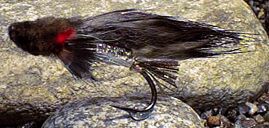|
|
This realistic pattern by Brad Hanson is basically the same as The THIEF only without the salmon egg added. Sculpin are a predominant prey species in most of Alaska's freshwaters and are taken by rainbow trout, steelhead, Dolly Varden char, northern pike, lake trout, cutthroats and sheefish as one of their basic staples. Its an effective pattern on small streams as well as the larger rivers.

|
- Head - olive "sculpin wool"
- Gill slit - red marabou
- Pectoral fins - olive mallard flank or other suitable feather (shaped/trimmed)
- Body hair - olive dyed deer hair
- Under body - pearlescent flashabou braid, lightly colored chenille, or dubbing
|
6. Weight - .030 lead wire or desired diameter
7. Overtail & upper Body - olive stripped rabbit
8. Tail base - Peacock hurl
9. Thread - olive Kevlar
10. Hook - #2 to #6 streamer, long
|
TYING:
- Cover the shank with thread from the eye to the bend to form a base.
- Tie in a small clump of peacock herl toward the rear where the shank begins to bend. Wrap the thread down firmly to form a flared tail, which adds substance and a natural sheen, as well as support for the 'stripped rabbit' tail segment. Trim the herl to leave 1/2 inch extending past the bend.
- Wrap the shank with .030 lead, leaving space behind the eye and in front of the tail, then overwrap the lead with tying thread to secure it in place.
- Tie in a 4-inch piece of stripped rabbit at the point where the herl tail begins. Leave 1 inch extending past the bend for the rabbit strip tail segment. ( The direction of the rabbit hair should be toward the rear for a streamlined appearance of the fly.)
- Move the tied in rabbit strip to a position out of the way so that it hangs off the tail end of the hook leaving the wrapped lead exposed. Just in front of the tail, tie in white pearlescent flashabou braid or other lightly colored chenille or dubbing then wrap the hookshank so that the lead is completely covered. Tie off at a point 1/4 inch behind the eye.
- Using mallard flank or other suitable feather; tie in pectoral fins on each side at the point behind the eye where the body material ends. The thread should be wrapped firmly to cause the fins to flare outward.
- Tie in a small clump of red marabou in front of both pectoral fins for gill color.
- Pull the 4-inch strip of rabbit over the underbody toward the hook eye and secure at the point where the body material ends 1/4 inch behind the eye. Remove excess rabbit by cutting off close to the hook shank.
- Cut a 1-inch long clump of deer hair and hold along the top of the body then tie in where the rabbit stopped. The thread should be wrapped down firmly to flare the hair. Repeat the procedure along bottom at the same tie in point. (The flared deer hair creates a smooth transition from the oversized head and adds substance to the largest part of the body.)
- Tie in two 1- inch long clumps of "sculpin wool" immediately behind the eye, positioning one along each side of the head. Pull the kevlar tying thread tightly in successive wraps drawing the center of the wool into the shank. Bring the thread forward between the clumps of wool along the top of the shank and whip finish at the hook eye.
- Grabbing the ends of the wool, pull outward in all directions at right angles to the tie in point to flare and fluff the wool to look like a cotton ball. Pull the wool into any area that needs to be covered.
- Trim the wool to form the desired head shape and cut the red marabou close to the shank leaving just a strip of red exposed.
Field Note - The head of the sculpin is a prominent and defining feature of this small fish. It's wider than any other part of the body and should be trimmed wide with flat planes on the top and bottom. The photo on this page doesn't reproduce the true Olive coloration of the materials used in this pattern due to graphic limitations.
Pattern by Brad Hanson
Photo by B. Hanson ©1999

|



